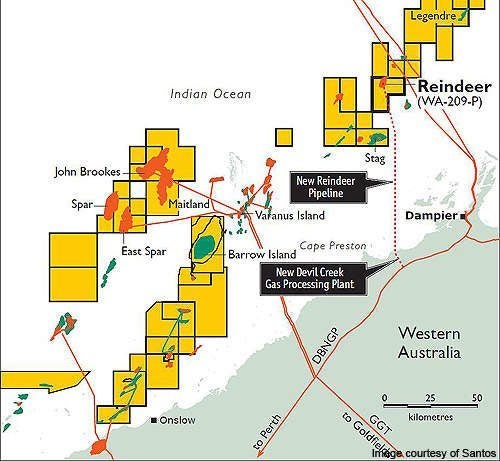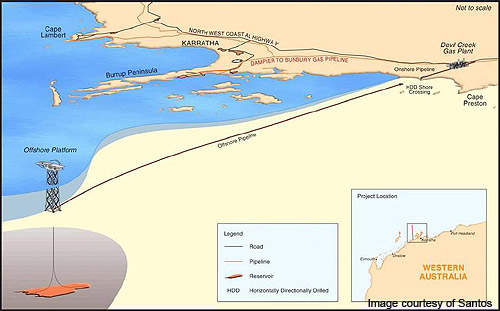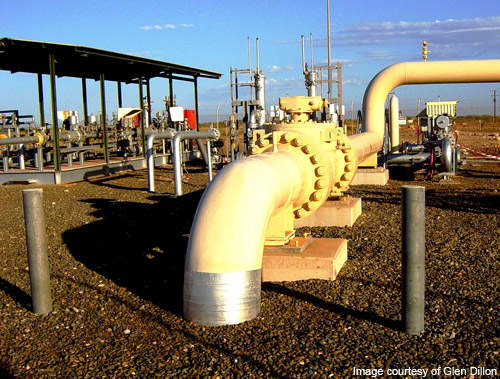Reindeer Gas Field is located in permit area WA-209-P of the Carnarvon Basin, 45km southwest of Dampier, offshore Western Australia.
Quadrant Energy is the operator of the Reindeer field with a 55% ownership, while the remaining 45% stake is held with its joint venture partner Santos.
Gas from the Reindeer field is produced through an unmanned wellhead platform and transported to the onshore Devil Creek gas plant, via a 105km-long pipeline.
The onshore gas plant has a processing capacity up to 220TJ of gas per day and 160kl of condensate per day. The processed gas is compressed and exported to the Western Australian domestic market through the Dampier-Banbury Natural Gas Pipeline.
First gas from the field was produced in December 2011. The $800m project will have a lifespan of 20 to 30 years. The production capacity of the field is approximately 110TJ (101 million cubic feet) a day of sales gas.
Santos signed a contract with Chinese company Citic Pacific in January 2009 to supply about 75PJ of natural gas for more than seven years to its Sino Iron project in Western Australia from the Reindeer gas project. The contract commenced in the second half of 2011.
Reserves of natural gas at the site
The Reindeer gas field is estimated to have proven and probable reserves of 485 peta joules (446 billion cubic feet) of commercial gas and 1.6 million barrels of condensate as per 2008 exploration studies.
Development of the Reindeer gas field
Reindeer was discovered in October 1997. Santos commenced the front end engineering and design (FEED) in 2007, which was finalised and approved in 2008.
Three wells were drilled using the Ensco 106 jack-up. The project was shelved in May 2009 due to the lack of a sales agreement.
It was resumed a month after the gas sales and purchase agreement was signed with Citic Pacific.
Construction commenced in September 2009 after receiving all necessary government approvals.
Infrastructure of the offshore site
The unmanned wellhead platform is built on a 1,200m² footprint. It weighs 1,700t and is 125ft tall. It is installed at a water depth of 65m.
Its substructure is a four legged jacket with one skirt file each. It has a four level topside processing module and helideck integrated to the main deck.
The well head platform was installed in two phases. Its jacket substructure with piles was installed first. The topside deck was installed on top of the jacket substructure later and the entire installation was completed in March 2011.
Pipeline running from the Australian gas field
A 16-in offshore gas pipeline connects the wellhead platform with the onshore gas plant. About 90km of the total 105km length of the pipeline was laid under water and the remaining pipeline is onshore to connect the processing facility.
The offshore pipeline is laid 60m deep under the water and has a 2.5km section drilled horizontally at Gnoorea Point to link with the 10km onshore pipeline. The area occupied by the offshore pipeline is 89,000m².
The pipeline was laid in two phases. The first phase included 23km of pipe installation in shallow water at a depth of five to 22m by the pipelay barge Leighton Stealth. Deep water laying was done in the second phase by the Sapura 3000 heavy lift vessel owned by SapuraAcergy.
Contracts awarded to companies
Santos awarded the contract for engineering, procurement and fabrication (EPF) of the wellhead platform to Perth-based Clough Engineering in June 2008.
The $200m contract involves transportation and construction of an unmanned wellhead platform and laying of a single gas pipeline. Clough Engineering deployed the Java Constructor vessel for the beach pull and Clough Challenge for the installation of pipeline.
Apache Energy awarded a $170m contract to SapuraAcergy for laying the offshore pipeline. Leighton was involved in laying the pipeline in shallow waters.
DrillTec performed the horizontal directional drilling. The company was assisted by ARV in the design, welding and health and safety issues. Geotechnical services and preparation of tenders, reviewing of documents and inputs for the environmental assessment were provided by Atteris.
Bombora Engineering Service Provider managed the pipeline design team during the project. Other contractors include Shenzhen Chiwan Sembawang Engineering, Barclay Engineering, Tamboritha and FoundOcean.




